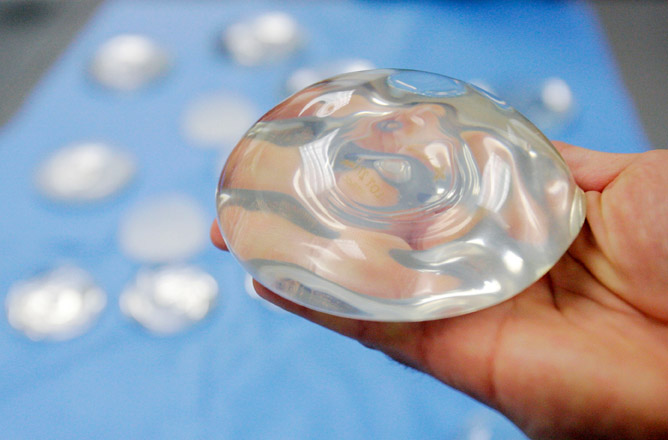WASHINGTON — Don’t expect breast implants to last for life, the government warned today: About 1 in 5 women who receive them for cosmetic reasons will have them removed within 10 years, and those odds are even higher for cancer survivors.
It’s not the first time the Food and Drug Administration has issued such a warning. But the agency repeated it Wednesday after reviewing new data on silicone-gel breast implants five years after they returned to the market following a health scare. The agency concluded the implants are basically safe as long as women understand they come with complications. Those include painful scar tissue and ruptured implants.
“The longer you have the implant, the more likely you are to have complications,” said FDA medical device chief Jeff Shuren. He said women should get regular checkups including scans to make sure the implants haven’t ruptured.
While FDA’s safety review concentrated on silicone-gel implants, the agency’s updated advice booklet for women makes clear that saline-filled versions come with the same complications — women getting those wind up back on the operating table, too.
Plastic surgeons say they’ve long told women about those risks.
“It doesn’t discourage a single one of them, which is pretty amazing,” said Dr. Michael Zenn, vice chief of plastic surgery at Duke University Medical Center. “This requires almost lifetime maintenance when you have a breast implant in. If you’re not telling patients that, you do them a disservice.”
Wednesday’s update is the latest in a 20-year saga over the safety of breast implants. The FDA banned the silicone-gel type in 1992 amid fears they might cause cancer, lupus and other diseases. But when research ruled out most of the disease concern, regulators returned the implants to the market in 2006 — with the requirement that manufacturers continue studying recipients to see how they fare long-term.
Breast augmentation remains the most popular cosmetic surgery in the U.S., with nearly 300,000 women undergoing it last year. According to the American Society of Plastic Surgeons, more than 70,000 others received implants for breast reconstruction. Silicone-gel implants are the most common kind.
Based on that data, FDA said Wednesday that 20 percent to 40 percent of patients who have implants for cosmetic reasons will need another operation to modify or remove them within eight to 10 years.
For reconstruction patients, the number is even higher at 40 to 70 percent, FDA said.
The most common complication remains scar tissue that hardens around the implant, and that can become severe enough to warp the shape of the breast or cause pain. Other problems include implant rupture, wrinkling and a lopsided appearance, according to the report.
The research also showed a small link with a very rare form of cancer known as anaplastic large cell lymphoma. The agency has learned of 60 cases of the disease worldwide, among the estimated 5 million to 10 million women with breast implants.
Why are reconstruction patients so much more likely to need another operation?
Radiation for breast cancer damages the skin so that over time it becomes stiffer, said Dr. Evan Garfein, a plastic and reconstructive surgeon at New York’s Montefiore Medical Center. It’s not uncommon for a woman who got two implants — so that both sides start out matching — to have the radiated side eventually appear tighter and higher on the chest as the tissue around it contracts. Also, women getting an implant after a mastectomy don’t have a natural layer of breast tissue to cushion it.
But Zenn said women getting cosmetic implants also need to understand that their breasts also will change with age or weight gain — and even if the implant doesn’t rupture or develop scar tissue, the skin and fat around it can droop or sag in unattractive ways. He advises women considering pregnancy to put off implants, because their breasts tend to change afterward, and says he won’t perform large implants that bring a greater risk of later revisions.
The FDA’s safety endorsement is primarily based on studies conducted by the two U.S. manufacturers of the products, Allergan Inc. and Johnson & Johnson’s Mentor unit.
But industry critics point out that most of the studies are still incomplete, and many women have already dropped out.
For example, only 58 percent of women enrolled in a 1,000-patient study of Mentor’s implants are still accounted for after eight years. A larger study of 40,000 women conducted by Mentor has lost nearly 80 percent of its patients after just three years. FDA officials said such studies should aim for a 85 percent follow-up rate.
Dr. Diana Zuckerman of the National Research Center for Women and Families said most medical journals would not publish the studies cited by the FDA because of the missing data.
“Once a medical product is approved, the manufacturers have no incentive to do these required studies properly,” Zuckerman said. “So, we end up with useless information, which is what has happened with the largest, most important studies of silicone gel breast implants.”
The FDA said it is working with Allergan and Mentor to increase study participation, including allowing participants to answer questions online or over the phone.
The head of the leading U.S. plastic surgery society said many patients skip follow-up appointments because they aren’t having any problems.
“When women are happy with their implants they tend to feel that a regular follow-up is pointless — it becomes a nuisance and an unnecessary expense,” said Dr. Phillip Haeck, president of the American Society of Plastic Surgeons.
Send questions/comments to the editors.


